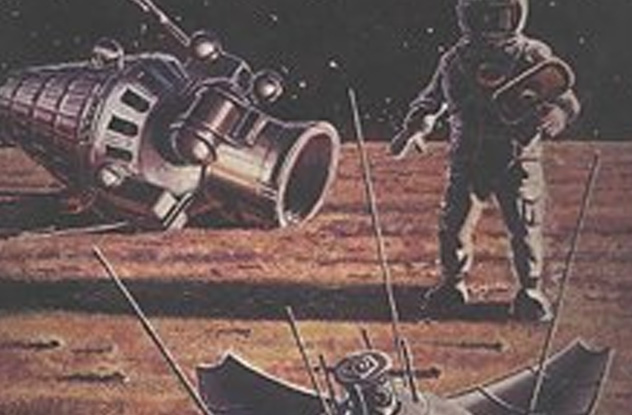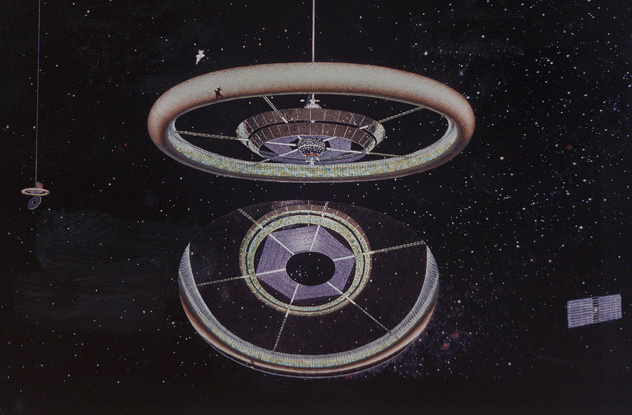Health
10 Crazy Ideas From The World Of Space Exploration
If, 100 years ago, you told people that a machine we made would secure on Mars and send us straight back pictures, most of them might have thought you outrageous. Thats the thing about space exploration. It really is these types of an innovative new concept with innovations made day-after-day that its difficult to differentiate research reality from science-fiction. All space-related tips seemed crazy at one point or another. Many of them worked and dont sound as crazy anymore. Other people are nevertheless quite available.
10The Squid Rover

Jupiters moon Europa is definitely regarded as a good prospect for extraterrestrial life as a result of large likelihood of the moon having oceans under an icy crust. We’ve been itching to send one thing truth be told there to see precisely what Europa provides. A proposed jv between NASA, ESA, as well as the Japanese and Russian area companies to schedule a mission to Europa in 2020 ended up being canceled because NASAs budget issues. At this time, an ESA-led goal known as JUpiter ICy moons Explorer (LIQUID) is scheduled for a 2022 launch. The probe would arrive on Europa in 2030. With regards to does, it might carry a very strange rover.
The unit concerned is a soft-robotic rover with electrodynamic energy scavenging. We call-it a squid rover because unique architecture plainly centered on that specific cephalopod. The style is made at Cornell University and had been approved by NASA for additional analysis. Its area of the brand-new NASA Innovative Advanced Concepts (NIAC) program, which, in its very own words, aims to turn science-fiction into technology reality.
The rover remains really in its early stages. It might feature tentacle-like frameworks that could harvest regional magnetized industries as an energy source, plus electroluminescent epidermis that would illuminate the underwater environment.
9Project HARP

From the realm of sci-fi, we proceed to the world of Looney Tunes. At the very least, thats what venture HARP would seem becoming at first glance. Quick for High-Altitude research study, it was a joint venture involving the United States Department of Defense plus the Canadian division of National Defense to deliver projectiles into room using a huge firearm.
The task had been started in 1961 mostly as a result of Canadian ballistics engineer Gerald Bull. He previously gotten the idea ten years earlier while taking care of ICBM missiles at Canadian Armaments and Research Development Establishment (CARDE). The project ended up being set-up on an airport in Barbados so projectiles could be fired when you look at the Atlantic Ocean. Initially, a 20-meter-long gun (65 ft) ended up being used, however it ended up being enhanced to 40 meters (130 ft) quite rapidly. The entire set up ended up being ready in 1962, nevertheless the Cuban Missile Crisis postponed the operation until the the following year.
Preliminary results were encouraging, and another test web site ended up being create in Yuma, Arizona. In 1966, this gun-shot a 180-kilogram (400 lb) projectile at a speed of 3,600 meters (12,000 ft) per second at an archive height of 180 kilometers (590,000 ft). As time passed, increasingly more backers destroyed desire for the task and pulled money. Sooner or later, the Vietnam War and worsening interactions between the United States Of America and Canada forced the project to power down. The weapon in Barbados remains today, a relic overlooking the Caribbean Sea.
8The Titan Submarine
Like Europa, Saturns moon Titan is seen due to the fact Holy Grail for space explorers. This has above-surface methane ponds and oceans we are simply itching to analyze. In 2004, the Cassini spacecraft mapped out the moon thoroughly and provided us a fairly good idea of their location. In 2005, the Huygens probe arrived on the moon and sent back the initial photographs from the area. The next phase would be to create something that could explore the depths of Titans oceans, as well as that, we are going to build a space submarine.
The submarine design had been suggested by Dr. Ralph Lorenz within Lunar and Planetary Science Convention and was authorized by NASA. If established, it could go for the Kraken Mare, Titans largest ocean. On the exterior, the drone would resemble an everyday submarine, aside from a large antenna that might be essential to transfer the data over a billion miles returning to world. But the circumstances on Titan would require the submarine to manage special problems. First of all, conditions on moon can attain 180 levels Celsius (290 F)
In addition, we no idea what depths the sub will need to cope with. The depth, as well as the seas composition, will likely make design elements like a traditional ballast tank unfeasible. The sub will even need an unique delivery system using a variant for the armed forces X-37B mini shuttle because decoration.
7Project Horizon

The area competition between the US additionally the Soviet Union caused probably the most effective age of area research. However, this is a whole new globe, still with its infancy, so a lot of trial-and-error ended up being needed to figure out what worked and what didnt. Ahead of the Apollo program finally place a guy on Moon in 1969, a great many other plans were made and scrapped.
Project Horizon is a recently declassified program associated with the US Army to construct an armed forces base on Moon. That task is excessively bold right now, however the program was developed in 1959. The army considered it possible to perform the beds base and equip it with troops and astronauts in the after decade.
Perhaps this was extremely optimistic associated with the army, or even it simply shows just how eager both edges were to achieve the top of submit the cool War. The report stressed how crucial it had been to determine a military presence regarding the Moon, great deal of thought only a matter of the time ahead of the Soviets tried the same.
The project never went further than the planning stage. It if had, it might have needed practically 150 Saturn rockets to be launched to transport the cargo. With regards to was completed, the bottom could have housed 1020 men and women. Until after that, the astronauts may have used all-natural holes located on the Moon, covered and sealed with force bags, to generate residing places.
6The Wrangler

The universe are a dangerous spot. A lot of things can snuff away life on our entire planet without an excessive amount of work: gamma-ray bursts, supernovas, colliding galaxies, plus. And, needless to say, one threat currently hit our world in the pastasteroids. Our planet is struck by asteroids during its 4.5 billion several years of existence, which is most likely that it will be hit once more as time goes on. It could take place the next day (it wont) or perhaps in a billion many years, but people at NASA are already considering solutions with this issue.
One option would be called the Weightless Rendezvous And Net Grapple to Limit extra Rotation (WRANGLER) system, thanks to Tethers Unlimited, Inc. This net and tether system might be implemented by a satellite to capture and de-spin an asteroid, making it (mostly) safe. This program was already accepted into the NASA Innovative Advanced Concepts Program, which is becoming developed as a less complicated, more affordable substitute for NASAs very own Asteroid Redirect Mission (ARM).
There’s two main components towards system. You’re the GRASP net capture device, together with other may be the SpinCASTER tether/winch mechanism. Utilizing the control of a tether, a tiny satellite can reduce steadily the angular energy of a much larger item. The WRANGLER has already proven effective in a microenvironment and it is increasingly being created to full-scale.
5Zvezda Moon Base

The Us americans werent truly the only ones keen to place an inhabitable base on the Moon. The Soviets were as eager. They began their particular lunar system in key with two objectives: very first, to complete a manned lunar flyby after which to actually land cosmonauts regarding the Moon. But the US beat all of them on both counts, and so the tasks were scrapped and kept concealed until the 90s.
Next up arrived the concept of building a permanent base on the Moon, known as Zvezda (Russian for star) or perhaps the DLB Lunar Base. The project started in 1962 and had been headed by lead Soviet room engineer Sergei Korolev. The moon base would have been made from nine split segments, each one with a specific purpose, particularly living quarters, dining, medical, or a laboratory. Collectively, they might have considered 18 tons, so they must be delivered separately. Additionally, the cosmonauts could have had accessibility Lunokhod robotic rovers to help them bypass on Moon.
The project received significantly more interest and funding after 1969, bolstered because of the People in america efforts. But its success relied regarding the effectiveness associated with the N1 rocket (the Russian exact carbon copy of the Saturn V rocket) accustomed provide heavy payloads beyond low-Earth orbit. When the N1 didn’t work properly, the rocket and all jobs dependent on it were canceled.
4The Stanford Torus

The Global universe has housed inhabitants for nearly 15 years. Mir had been operational from 1986 until 2001. However, while huge in size, these channels are not actually intended to house a lot of people. Mir had a crew of three. The ISS features a capacity to support six residents, although it today currently features three people aboard. The Stanford torus had been a little more bold than that. It had been a concept for a place habitat supposed to support 10,000 men and women.
The plan for this design came in 1975 as the result of a summertime research organized by NASA and Stanford University. It consisted of a torus (a donut-shaped band), that has been 1.5 kilometers (1 mi) in diameter and ended up being effective at carrying out the full rotation every minute to replicate Earths gravity.
The Stanford torus never advanced through the concept stage. The look when it comes to torus needed 10 million a great deal of material, almost all of it obtained from the Moon and from asteroids. Just materials unavailable there would-have-been brought over from Earth. The space station would have been positioned during the Earth-Moon L5 Lagrangian pointa point in which a little object between two large bodies is afflicted with their gravity so that it can keep a stable position.
3Printable Spacecraft

3-D publishing seems to be technology into the future, with very little limit as to the it could accomplish. Our company is already capable of printing versatile electronics that work on common customer items like cell phones. They’re not just less expensive and simpler to help make but also smaller and less heavy. One bold concept coming out of NASAs own Jet Propulsion Lab (JPL) suggests that, as time goes by, we possibly may manage to print entire spacecraft.
The Printable Spacecraft is another program appearing out of the NIAC. It really is at this time in Phase 2, therefore it has already undergone and been successful in its initial objective, which was to see if it had been feasible to print all of the electronics required for a functional spacecraft. The 2nd phase features a few new goals, including really printing a benchtop model spacecraft. NASA must also determine how practical its to produce a printed spacecraft for just one mission.
If every thing works, NASA thinks that cheap and effective printed spacecraft will revolutionize area research. It estimates that some kind of working model is all about ten years away, but inaddition it imagines exactly how, into the remote future, you might just carry a printer to you and create whatever probes or crafts you will need onsite.
2Venus Landsailing Rover

Venus is certainly not a really friendly spot. As a result of conditions that reach 450 levels Celsius (840 F) and a corrosive atmosphere, exploring our neighboring planet has proven to-be very difficult. To date, best we’re able to do was land a stationary rover on the surface of Venus that remained working for an impressive a couple of hours. Compare that into the rovers that work for years and years on Mars, and then we note that checking out Venus continues to be one of our many ambitious targets despite its close proximity.
Today, we have a new method thanks to the NASA Glenn Research Centerthe Venus Landsailing Rover. Dubbed the Zephyr, this brand-new rover dates back to essentials and seeks to harness the effectiveness of the wind for propulsion, just like a typical sail. While Venus doesnt have quite strong winds (they only achieve around 3 kilometers [2 mi] per hour), pressure in the world would ensure that also a little snap ended up being with the capacity of generating considerable energy.
The Zephyr would be built from products over effective at withstanding the high conditions. It would mainly remain fixed, only deploying its sail when it has to proceed to a unique spot. That is helped by Venuss flat landscape, that has not many obstructions. Making use of these types of a conservative approach to energy usage, NASA estimates that Zephyr could endure a whole thirty days on the planet.
1Project Orion

Space vacation requires some sources, so we will always on the lookout for brand new prospective resources of energy better than everything we already have. In the 1950s, it seemed like absolutely nothing ended up being more powerful than the atomic bomb. A continuing effort desired new uses for this amazing energy source that werent because destructive as its primary function. Maybe it may be familiar with power a spacecraft?
The idea of nuclear pulse propulsion was created by physicists Ted Taylor and Freeman Dyson. They worked on their particular program, called Project Orion, to build up an easy method of propelling a spacecraft using a few atomic bomb detonations behind it. The thought of a nuclear drive was not a brand new one. This notion was indeed previously investigated by Stanislaw Ulam, a Polish-American mathematician who participated when you look at the Manhattan Project.
Work with the project were only available in 1958. In the past, NASA didnt exist yet, therefore undertaking Orion was financed by the Advanced studies Agency (ARPA) of this division of Defense, which just had a passing interest. Whenever NASA had been founded, it while the Air energy divided up ARPAs jobs, with Orion omitted in cold, as nobody saw it as a secured asset. It would be a couple of years before NASA got involved, but at that time, the Limited Test Ban Treaty of 1963 on nuclear tools managed to get impossible for Orion to develop, because of the large amounts of potential atomic fallout.
Radu is a history/science buff with an interest in every things bizarre and obscure. Share the information on Twitter, or consider their internet site.
